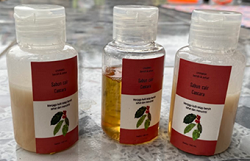Potensi Limbah Kulit Biji Kopi dan Pemanfaatannya sebagai Produk Sabun Cair yang memiliki Aktivitas Antioksidan dan Antibakteri Potential of Coffee Bean Peel Residue and Its Use in a Liquid Soap with Antioxidant and Antibacterial
Main Article Content
Abstract
Numerous coffee plantation workers are members of the Neglasari village farmer group, located in Sukawangi village, Bogor district. The problem frequently raised is coffee bean residue, which is typically discarded and provides an idea for the group to consider using it. This issue can be remedied by providing knowledge and direction regarding possible coffee bean husk residues. According to earlier studies, coffee bean skin includes polyphenols with potential antibacterial and antioxidant properties, allowing it to be formulated into skin-safe liquid soap solutions. Participants are productive-age men and female farmers with a constant motivation for entrepreneurship. Participants were provided with a direct explanation of the possibilities of coffee bean husk residue, followed by a short training on manufacturing liquid soap. Comparing the outcomes of the pre-test and post-test provided to participants is an indication of the activity's efficacy. Based on the collected results, it can conclude that the participant's comprehension of the presented material increased significantly (p < 0.05). It anticipated that the outcomes of this product development education and training would enable Farmer Group members to become home-based entrepreneurs.
Downloads
Article Details

This work is licensed under a Creative Commons Attribution-ShareAlike 4.0 International License.
Authors who publish with this journal agree to the following terms:
- Any article on the copyright is retained by the author(s).
- Author grant the journal, right of first publication with the work simultaneously licensed under a Creative Commons Attribution License that allows others to share work with acknowledgment of the work authors and initial publications in this journal.
- Authors are able to enter into a separate, additional contractual arrangements for non-exclusive distribution of published articles of work (eg, post-institutional repository) or publish it in a book, with acknowledgment of its initial publication in this journal.
- Authors are permitted and encouraged to post their work online (e.g., in institutional repositories or on their websites) prior to and during the submission process, as can lead to productive exchanges, as well as earlier and greater citation of published work.
- The article and any associated published material is distributed under the Creative Commons Attribution-ShareAlike 4.0 International License
References
Arwati, I.G.A., Anggraini, R. 2016. Penyuluhan Pembuatan Pencuci Piring Ramah Lingkungan di Wilayah Jakarta Barat. Jurnal Abdi Masyarakat (JAM). 2(1):25–30. https://doi.org/10.22441/jam.2016.v2.i1.004
Hidayat, M. 2018. Perkebunan Kopi di Bogor Didominasi Robusca dan Arabika. Cendawa News. https://www.cendananews.com/2018/09/perkebunan-kopi-di-bogor-didominasi-robusta-dan-arabika.html
Hikmah, N., Surawan, Ansari, M.R., Endah, Muslimah. 2022. Pelatihan Peningkatan Kompetensi Guru dalam Membuat Media Pembelajaran Berbasis IT di SMP Muhammadiyah Palangka Raya. PengabdianMu: Jurnal Ilmiah Pengabdian Kepada Masyarakat. 7(5):652–663. https://doi.org/10.33084/pengabdianmu.v7i5.3175
Kristianingsih, I., Wiyono, A.S. 2015. Penggunaan Infusa Daun Alpukat (Persea americana Mill.) Dan Ekstrak Daun Pandan (Pandanus amarryllifolius Roxb) Sebagai Peluruh Kalsium Batu Ginjal Secara In Vitro. Jurnal Wiyata: Penelitian Sains dan Kesehatan. 2(1):93–101. https://doi.org/10.56710/wiyata.v2i1.4343
Maliza, R., Aulah, J., Aji, O.R. 2020. Antibacterial Activity of Coffee Arabica (Coffea arabica L.) Fruit Skin Methanol Extract on Bacteri Eschericia coli and Staphylococcus aureus. Bioscience. 4(2):162-171. https://doi.org/10.24036/0202042108692-0-00
Margayaningsih, D.I. 2020. Peran Kelompok Wanita Tani Di Era Milenial. Publiciana. 13(1):52–64. https://doi.org/10.36563/publiciana.v13i1.205
Munira, M., Mastura, N., Nasir, M. 2020. Uji Antibakteri Kulit Buah Kopi (Coffea arabica L.) Gayo Berdasarkan Tingkat Kematangan terhadap Escherichia coli. Indonesian Journal for Health Sciences. 4(2):84–90. https://doi.org/10.24269/ijhs.v4i2.2640
Muzdalifa, D., Jamal, S. 2019. Uji Aktivitas Antioksidan Ekstrak Fraksi Kulit Biji Kopi Robusta (Coffea canephora Pierre ex A.Froehner) terhadap Pereaksi DPPH (1,1-Difenil-2-Pikrilhidrazil). Іndоnеѕіа Nаturаl Rеѕеаrсh Рhаrmасеutісаl Jоurnаl. 4(2):41–50. https://doi.org/10.33024/jfm.v4i1.4470
Pemerintah Daerah Kabupaten Bogor. 2019. Kopi Nikmat Andalan Kecamatan Sukamakmur. https://bogorkab.go.id/post/detail/kopi-nikmat-andalan-kecamatan-sukamakmur
Saisa, & Syabriana, M. 2018. Produksi Bioetanol Dari Limbah Kulit Kopi Menggunakan Enzim Zymomonas Mobilis Dan Saccharomyces Cereviseae. Jurnal Serambi Engineering. 3(1):271–278. https://doi.org/10.32672/jse.v3i1.356
Setiadi, D. 2021. Potensi Pengembangan Ekonomi Petani Kopi di Kabupaten Bogor. Radar. 2(1):1–7.
Suloi, A.N.F., Syam, N.F., Jufri, N., Sari, R., Mahendradatta, M. 2019. Pemanfaatan Limbah Kulit Kopi sebagai Upaya Pemberdayaan Ibu-ibu Rumah Tangga di Desa Latimojong, Kabupaten Enrekang. Agrokreatif: Jurnal Ilmiah Pengabdian Kepada Masyarakat. 5(3):246–250. https://doi.org/10.29244/agrokreatif.5.3.246-250
Winahyu, D.A., Marcellia, S., Diatri, M.I. 2021. Uji Aktivitas Antioksidan Ekstrak Kulit Biji Kopi Robusta (Coffea canephora Pierre ex A.Foehner) dalam Sediaan Krim. JFM (Jurnal Farmasi Malahayati). 4(1):82–92. https://doi.org/10.33024/jfm.v4i1.4470
Yeni, Y., Nining, N. 2020. Pelatihan Pembuatan Sabun Scrub Kopi Berbasis Komoditas Lokal untuk Alternatif Usaha Baru di Kecamatan Sukamakmur Kabupaten Bogor. Prosiding Abdimasmu. 1(2):111–117.
